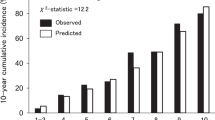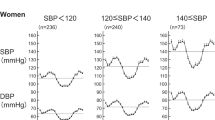Abstract
The vascular endothelium maintains a relatively vasodilated state via the release of nitric oxide (NO), a process that could be disrupted by hyperhomocysteinaemia. Since endothelial dysfunction is associated with increased systemic vascular resistance that is the hallmark of sustained arterial hypertension, we hypothesised that in patients with both hypertension and coeliac disease with hyperhomocysteinaemia (via malabsorption of essential cofactors), treatment of the latter disease could improve blood pressure (BP) control. A single patient with proven sustained hypertension and newly-diagnosed coeliac disease had baseline and post-treatment BP and endothelial function assessed by ambulatory BP monitoring (ABPM) and brachial artery forearm occlusion plethysmography respectively. This 49 year-old woman had uncomplicated sustained hypertension proven on repeated ABPM carried out 6 weeks apart (daytime mean 151/92 mm Hg and 155/95 mm Hg), and sub-clinical coeliac disease (gluten-sensitive enteropathy). Initial assessments revealed raised homocysteine levels with low normal vitamin B12 level. It was likely that she had impaired absorption of essential cofactors for normal homocysteine metabolism. She adhered to a gluten-free diet and was give oral iron, folate and B6 supplementations as well as B12 injections for 3 months. Her BP had improved by 6 months and normalised by 15 months (daytime ABPM mean 128/80 mm Hg). There was parallel restoration of normal endothelial function with normalisation of her homocysteine levels. These observations suggest that sub-clinical coeliac disease related hyperhomocysteinaemia might cause endothelial dysfunction, potentially giving rise to a reversible form of hypertension. In addition, this case study supports the notion that irrespective of aetiology, endothelial dysfunction may be the precursor of hypertension. This highlights the need to resolve co-existing vascular risk factors in patients with hypertension.
This is a preview of subscription content, access via your institution
Access options
Subscribe to this journal
Receive 12 digital issues and online access to articles
$119.00 per year
only $9.92 per issue
Buy this article
- Purchase on SpringerLink
- Instant access to full article PDF
Prices may be subject to local taxes which are calculated during checkout


Similar content being viewed by others
References
Furchgott RF, Zawadzki JV . The obligatory role of endothelial cells in the relaxation of arterial smooth muscle by acetylcholine Nature 1980; 288: 373–376
Taddei S, Salvetti A . Pathogenetic factors in hypertension. Endothelial factors Clin Exp Hypertens 1996; 18: 323–335
McAllister AS et al. Basal nitric oxide production is impaired in offspring ofpatients with essential hypertension Clin Sci (Colch) 1999; 97: 141–147
Duffy SJ et al. Treatment of hypertension with ascorbic acid Lancet 1999; 354: 2048–2049
Ribeiro MO et al. Chronic inhibition of nitric oxide synthesis. A new model of arterial hypertension Hypertension 1992; 20: 298–303
Baylis C, Mitruka B, Deng A . Chronic blockade of nitric oxide synthesis in the rat produces systemic hypertension and glomerular damage J Clin Invest 1992; 90: 278–281
Celermajer DS et al. Cigarette smoking is associated with dose-related and potentially reversible impairment of endothelium-dependent dilation in healthy young adults Circulation 1993; 88: 2149–2155
Vogel RA . Cholesterol lowering and endothelial function Am J Med 1999; 107: 479–487
Shige H et al. Endothelium-dependent flow-mediated vasodilation in the postprandial state in type 2 diabetes mellitus Am J Cardiol 1999; 84: 1272–1274
Tawakol A et al. Hyperhomocyst(e)inemia is associated with impaired endothelium-dependent vasodilation in humans Circulation 1997; 95: 1119–1121
Kannel WB . Fifty years of Framingham Study contributions to understanding hypertension J Hum Hypertens 2000; 14: 83–90
Hankey GJ, Eikelboom JW . Homocysteine and vascular disease Lancet 1999; 354: 407–413
O'Brien E et al. Use and interpretation of ambulatory blood pressure monitoring: recommendations of the British hypertension society BMJ 2000; 320: 1128–1134
Butler R, Morris AD, Burchell B, Struthers AD . DD angiotensin-converting enzyme gene polymorphism is associated with endothelial dysfunction in normal humans Hypertension 1999; 33: 1164–1168
Kanani PM et al. Role of oxidant stress in endothelial dysfunction produced by experimental hyperhomo-cyst(e)inemia in humans Circulation 1999; 100: 1161–1168
Sutton-Tyrrell K, Bostom A, Selhub J, Zeigler-Johnson C . High homocysteine levels are independently related to isolated systolic hypertension in older adults Circulation 1997; 96: 1745–1749
Nygard O et al. Plasma homocysteine levels and mortality inpatients with coronary artery disease N Engl J Med 1997; 337: 230–236
Katusic ZS . Vascular endothelial dysfunction: does tetrahydrobiopterin play a role? Am J Physiol Heart Circ Physiol 2001; 281: H981–H986
Doshi SN et al. Folate improves endothelial function in coronary artery disease: an effect mediated by reduction of intracellular superoxide? Arterioscler Thromb Vasc Biol 2001; 21: 1196–1202
MRC Vitamin Study Research Group. Prevention of neural tube defects: results of the Medical Research Council Vitamin Study Lancet 1991; 338: 131–137
Feighery C . Fortnightly review: coeliac disease BMJ 1999; 319: 236–239
Paniagua OA, Bryant MB, Panza JA . Transient hypertension directly impairs endothelium-dependent vasodilation of the human microvasculature Hypertension 2000; 36: 941–944
Tzemos N, Lim PO, MacDonald TM . Nebivolol reverses endothelial dysfunction in essential hypertension: a randomized, double-blind, crossover study Circulation 2001; 104: 511–514
Acknowledgements
We especially wish to thank the patient who was the subject of this paper for her magnanimity in participating actively with us in testing out a scientific hypothesis.
Author information
Authors and Affiliations
Corresponding author
Rights and permissions
About this article
Cite this article
Lim, P., Tzemos, N., Farquharson, C. et al. Reversible hypertension following coeliac disease treatment: the role of moderate hyperhomocysteinaemia and vascular endothelial dysfunction. J Hum Hypertens 16, 411–415 (2002). https://doi.org/10.1038/sj.jhh.1001404
Received:
Revised:
Accepted:
Published:
Issue date:
DOI: https://doi.org/10.1038/sj.jhh.1001404
Keywords
This article is cited by
-
The association between total homocysteine and blood pressure in two independent Chinese populations
Journal of Human Hypertension (2020)
-
B vitamins related to homocysteine metabolism in adults celiac disease patients: a cross-sectional study
Nutrition Journal (2015)
-
Polymorphic variants of genes involved in homocysteine metabolism in celiac disease
Molecular Biology Reports (2012)



